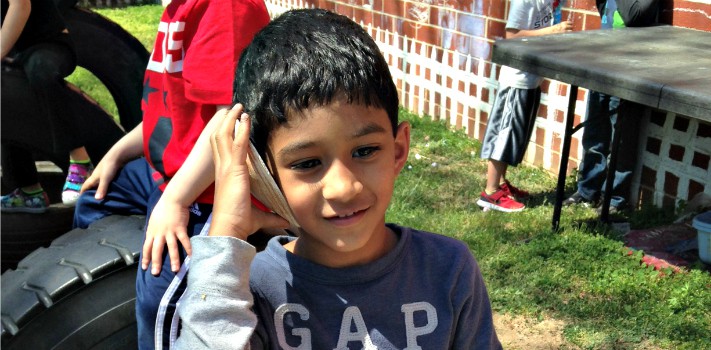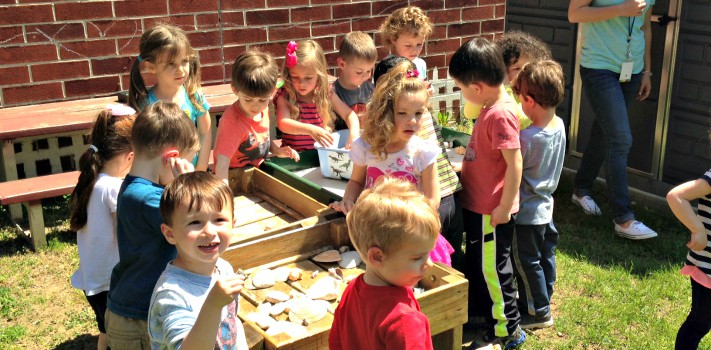Mid-Island Y JCC Builds a Nature Classroom
If we want children to care for the environment and the world, we need to give them an incentive.
Story
Seven hours and 38 minutes. That’s how long the average American child spends using digital devices each day.
All that screen time is preventing children from having “green time” – playing outside. Educators found that spending too much time indoors can harm a child’s development. This so called “nature deficit disorder” is thought to play a role in a range of behavioral and medical problems, including childhood obesity, nearsightedness, and poor attention spans.
Playing in nature as a child can also inspire a lifelong passion for protecting the environment.
“If we want children to care for the environment and the world, we need to give them an incentive,” said Rhya Jerrold, early childhood director who participated in the Jewish Greening Fellowship (program that preceded the Hazon Seal) on behalf of the Mid-Island Y JCC in Long Island.
Rhya wanted to giver her preschool students a chance to leave the confining walls of the building and be able to see plants and animals up close.
A large, underused interior courtyard caught her eye. Children occasionally played there with plastic toys, but they hardly noticed they were outside. In its place, Rhya envisioned a lush nature classroom for free play, biology lessons, and nature exploration.
Rhya wanted every inch of the space to promote learning and sustainability. There would be a music corner where children could play instruments made from natural materials. A builder’s corner would allow children to build structures using small bricks and wooden blocks instead of plastic. Pear and apple trees would scatter the courtyard, offering kids a chance to understand the cycle of growth and harvest. A greenhouse would also be built to give children a chance to grow food in winter months.
Rhya convinced the JCC administration of the the project’s merits. She faced a massive challenge: Where would Mid-Island Y find the $10,000 needed for the upgrades?
The Jewish Greening Fellowship (which is the program that laid the foundation for the Hazon Seal of Sustainability) and the local community stepped up to make her vision a reality. About 30% of the funds came from a Greening Fellowship grant; for the rest, Rhya turned to parents of children enrolled in the JCC’s early childhood programs.
Institutions across the Jewish community have found that greening projects attract new donors who are energized about environmental issues. The JCC was no different. Parents organized a series of successful fundraisers, including a comedy night, which raised $7,000, enough to cover the remaining costs of creation and installation.
Rhya and her team of parents found other ways to cut costs. They bought a greenhouse kit instead of having one custom-designed. They also laid their own stage instead of using a contractor. Home Depot donated select supplies for the classroom, and Starbucks volunteers joined the team of parents and JCC staff in installing it.
Over eight laborious days in August, the classroom took shape: the crew mixed cement, wheeled in rocks, assembled the greenhouse, dug holes in the ground with rented equipment, and planted trees.
After the classroom opened, Rhya worked with the Arbor Day Foundation’s “Nature Explore” program to draft a curriculum for the new space. The JCC hired a nature educator to help them utilize the classroom more effectively. All teaching staff also took part in a series of professional development trainings on interactive nature education.
Today, the nature classroom buzzes with activity. Each week, almost 300 toddlers and nursery school aged children use the space, along with senior citizens and specials needs children on a rotating basis. Even outside groups have asked to use the classroom.
Teachers from other Jewish institutions have received training at the Mid-Island Y on nature education. The JCC and North Shore Synagogue co-sponsored family workshops to show parents how to teach their kids about the outdoors. The classroom has become a central part of the JCC, both literally and figuratively.
“It wasn’t easy to get the classroom built, but I love the momentum that it has gained since then,” Rhya said. “The kids love it out there.”
Lessons in the classroom highlight environmental values, like the importance of recycling and avoiding littering. Jewish values are present, too, especially around Jewish holidays. Before Passover, for example, the children gather parsley they’ve grown to use as the karpas herb at their Seder. around Sukkot, the harvest holiday, they pick apples and pears.
“We want children to have a connection to the outdoor world,” Rhya said. “We don’t want them to be afraid they’re going to melt in the rain or snow. This place gives them a chance to learn that.
Jewish Values
- The Jewish calendar is intricately tied to the march of the seasons, and the three major holidays of the year are intricately connected to the agricultural cycle. Passover heralds the spring, Shavuot welcomes the summer, and the year’s first fruit harvests, and Sukkot, the autumn holiday of bounty, presages winter. According to Jewish tradition, the Jewish people were birthed in the wilderness, wandering for decades through the harsh realities of a desert untouched by human hands. On Sukkot, we commemorate these wanderings by leaving our own sturdy homes and living for a week outdoors. Here, exposed to the elements, we reclaim our ecological niche and inevitably rediscover the thriving natural world of which we are a part.
- “And Isaac went out to meditate in the field towards evening…” (Genesis 24:63). In this verse, the patriarch Isaac leaves his tent and wanders into a field, shortly before he meets his bride-to-be, Rebecca. The rabbis of the Talmud concluded that Isaac went outside to pray, and derived mincha, the afternoon prayer service, from this verse (Talmud Bavli, Berakhot 26b). Revelation, they seem to be saying, is possible only when we enter the natural world. Rebbe Nachman of Braslov, an 18th-century Hasidic mystic, popularized the practice of hitbodedut, or “self-seclusion,” — that is, secluding oneself in silent meditation, usually in nature, in order to connect to God. “It is good to pray and dialogue with God in the field amongst the grass and trees,” Rebbe Nachman said. “When a person prays in the field then all the plants and animals join in the prayer and help him or her, giving strength to the prayer.”
Education Ideas
- Educate parents by hosting a discussion about Last Child in the Woods, a book about nature deficit disorder.
- During seasonable weather, hold a staff meeting or a class in the garden.
- Build a Sukkah in or next to your building.
-
Organize a foraging activity where students learn how to identify edible and medicinal plants.
-
Have students guide each other blindfolded to places they think are beautiful and explain why.
- Have students sit silently for two minutes and document everything they hear. Then discuss together what sounds they noticed.
More Project Ideas
- Trailblazing: The Community Synagogue of Rye built a “Teva Trail” for teens to explore nature on their synagogue’s property.
- Roof Garden: The Abraham Joshua Heschel School installed a rooftop garden, which allows students to play outdoors and spend time gardening in the middle of Manhattan.
- Holiday garden: The Solomon Schechter School of Long Island planted a Jewish holiday garden, with a bed for each holiday. For example, students planted potatoes (for latkes) in the Chanukah bed. They also tended a “pe’ah” bed, referring to the Torah commandment to leave the corners of one’s field for the poor. Food from the bed was donated to a food bank.
- Tashlich: The Reconstructionist Synagogue of the North Shore heads to the water and does tashlich, the ceremonial casting away of sins, on kayaks.
- Park Rangers: The Riverdale Y partnered with New York City Park Rangers to do nature education programs at their farmers’ market.
Resources
For more resources, go to our greening resources page and look under the Kids and Education Tab.





